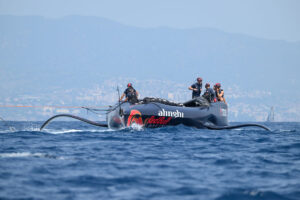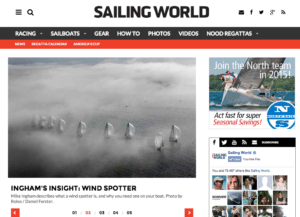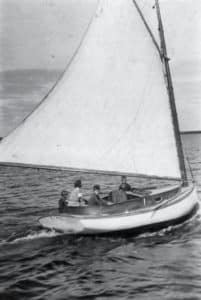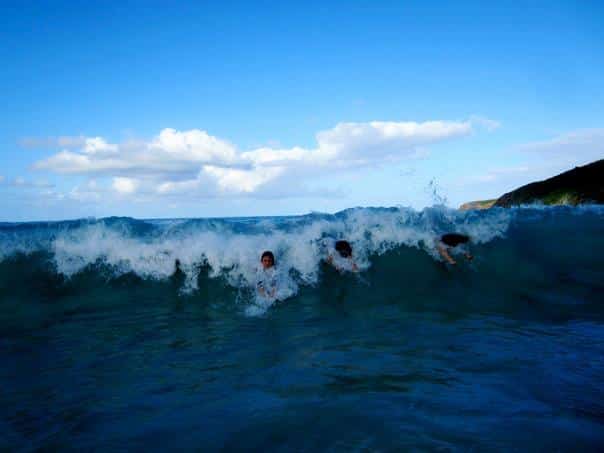
Flamenco bodysurfing
If you want to experience the ocean, go sailing. If you want to commune with the ocean, go body surfing.
That, at least, is my conclusion after surfing the same beach each Christmas over a period of about 10 years. I must have put myself into more than a thousand waves over that period of time, humbly submitting myself to the immense power and sublime beauty of each and every one of them. Each wave delivered something special and unique: a rush of water, the sensation of speed and power, and a brief and total immersion into the watery world. No matter how many waves I surfed, each ride was its own thrill and had its own story.
True reverence for the sensation and experience of body surfing a wave was only fully realized over time, and it snuck up on me. It started with a beach called Flamenco, on the island of Culebra, off the East Coast of Puerto Rico. I first discovered Culebra in 1998, when I sailed my Bristol 35.5 to the Caribbean and spent a night in Manglar Bay simply because Don Street said it was one of the 10 best anchorages in the entire Caribbean (he’s right, but from a seaman’s point of view, as opposed to a night-clubbing/cruiser point of view). As coincidence would have it, a few years later my parents and some relatives went in together to build a house on a point overlooking Manglar Bay. Christmas in Culebra became part of the family tradition.
Culebra is an island of beautiful beaches and little development. The beach of beaches, as far as the the crowds (though it is hard to ever call Culebra crowded) and my kids are concerned, is Flamenco. It’s a picture-postcard long half-moon of sugary sand, turquoise water, and astoundingly reliable surf.
I’m not sure what generates such good surf at Flamenco. The topography of the bay and shape of the seafloor must have a lot to do with it. But mostly I think it has to do with the fact that it is a northerly-facing beach, open to big swells that come rolling south into the Caribbean from Atlantic lows and fronts. Whatever the specifics, and though the surf varies in size from mild to heart-pounding, it is rarely too little or too big for a good body-surfing session.
Just as important, there is something about the shape of the waves that makes it a better body-surfing beach than surfboard-surfing beach. That means that for me and my kids (and numerous other members of my extended family), Flamenco is for one thing and one thing only: regular and reliable body-surfing sessions which never fail to deliver the sensations our psyches have come to crave.
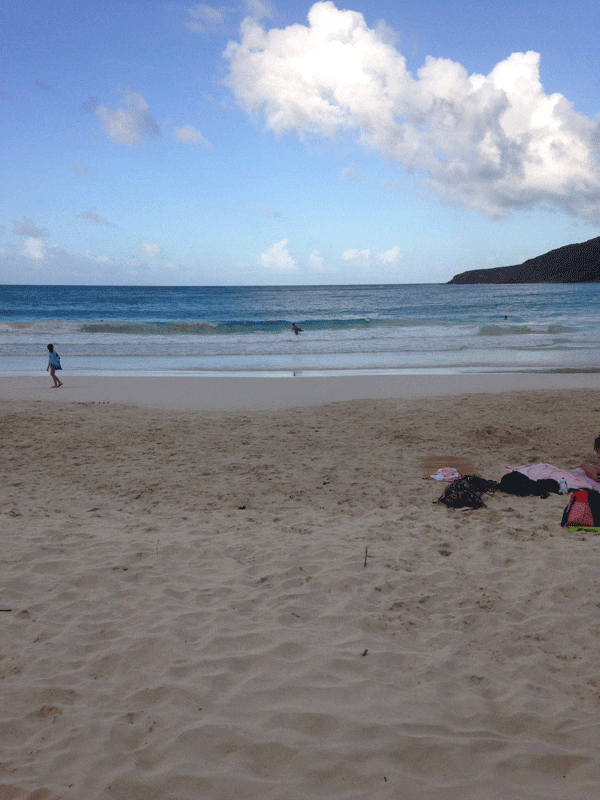
Photo: Natasha Zimmermann
When we first started going to Flamenco my son, Jamie, and daughter, Natasha, were toddlers. They wore life jackets. We took boogie boards. Their mother worried they were too small to be in the surf. Sometimes I pushed them onto waves they didn’t want to go on because they were too big, and they sometimes got rolled as a result. They yelled at me. My wife yelled at me. But over time they learned what surfing a wave was all about and started to love going to Flamenco. After a few years, if you asked at breakfast what everyone wanted to do that day, to my wife’s regret (because she likes new places and new experiences) the answer was always the same: go to Flamenco. A daily trip to Flamenco (especially with their older cousin Arthur) became a non-negotiable part of a Culebra day. Natasha and Jamie stopped seeing many waves as too big. Instead, they started seeing many waves as too small.
At first, I went because they wanted to go. Boogie boarding was fun, and it was easy to catch waves. But you rode on top of the waves, you didn’t feel part of the ocean. It was like a good amusement park ride. As time passed, and boogie boards broke, and we got tired of schlepping them around, the boogie boards disappeared. All you needed to surf Flamenco, we realized, was a bathing suit.
That changed the experience. As soon as we arrived at Flamenco the kids would tear onto the beach and race into the water. Within minutes they would inevitably be set up in the right place to surf waves that day, at that particular tide, standing in just the right place in the break to have the best chance of catching a good ride. I would follow them. Everyone would scan the horizon, looking for the telltale humping a couple of hundred yards out that foretold the arrival of a good set. We started to speak Flamenco-speak.
“I think I see some big waves coming.”
“Yep, second one looks best.”
“Quick, get deeper.”
“Here it comes. It’s a rider.”
“I’m going. You going?”
Then the wave would be upon us. Sometimes it was big enough that you’d hear a lot of oohs and ahhs. It would sweep in and start to peak. The crest would start to curl. And you’d launch, hoping you had the timing just right. If you did, the wave would pick you up and hurtle you toward the beach. You’d be encased in water, the rush of it would fill your ears, and send tingles down your spine. You’d feel your body tilt down as the wave started to break, and you’d hope for a smooth transition. If it was a big one, that brief moment between stable flight and whitewater chaos, which could either end with you getting slammed into the sand or experiencing the exhilarating rush of miraculous salvation, could feel as important as any moment in your life. Sometimes you’d get washing-machined, and come up spitting seawater, dizzy and disoriented. Anyone who had ducked the wave or missed it would laugh and ask, often facetiously (given they had probably just seen your feet peddling frantically in the air as you executed a spectacular somersault), “Did you get rolled?”
Most times, your body would tilt down toward the sand and accelerate. The wave would crash all around you and rocket you up the beach. You’d hold your breath, lie still, and see how far it would carry you. When you couldn’t hang on any longer, you’d come up with a big gasp and look around to see who was still with you. Sometimes four or five of us would catch the same wave, and we’d look at each other with satisfaction, silently acknowledging the shared experience of a good wave, well-ridden. Being farthest up the beach was a subtle honor. We’d all laugh at the thrill of it, and wade back out into the break, eager to catch another one.
Putting ourselves into wave after wave taught us a lot about the characteristics of the waves, and what worked, and what didn’t. We learned that an incoming wave could sometimes flatten out just before breaking (especially if a previous wave was a big one and lots of water was coming off the beach). When that happened, almost invariably, no matter how hard you swam, you’d fail to hook into the wave and get left behind, wasting effort and perhaps missing the next wave–which of course would be perfect. “Too flat, too flat!” the cry would go up, and everyone except the hopeless optimists all around us would duck and wait for a better prospect.
We learned that sometimes the waves would develop two crests, the smaller preceding the bigger. And that even if you caught the bigger crest the ride would fizzle as it over-ran the smaller crest, and you’d lose a clean and decisive break. The kids were ever vigilant. Other people in the water might get excited at the sight of a seemingly decent wave rolling toward them. But Tasha, Jamie, and Arthur wouldn’t be fooled. “It’s a double,” they’d tell each other dismissively, and duck, as all the other suckers tried to ride a wave that wouldn’t ride.
Over the years, I loved to see how in tune with the Flamenco waves the kids became, and how good they got at reading them and riding them. Other kids would sometimes gravitate towards Arthur, Jamie, and Natasha, keying off their confident patter as they read the waves and made Go/No-Go decisions. If Arthur, Jamie, and Natasha went, they went. If they ducked, their attentive disciples would duck. In the eyes of (at least some) others, with their sophisticated evaluations and group cohesion, Arthur, Jamie, and Natasha were gurus of Flamenco, the ungrizzled veterans of the local surf. Maybe one day we’ll have to go here …
Because I was at Flamenco with them, I would surf alongside the kids, revelling in their pleasure. Slowly, the experience of repeatedly immersing myself in wave after wave, and joining each one for the climactic moment of its life-cycle, worked its magic on me. I grew to love the experience of clawing my way onto the face of a reluctant wave and suddenly feeling the effort rewarded by a hissing acceleration as the wave finally accepted a passenger. I grew to love briefly merging my body fully in the infinite forces and sensations that constitute a breaking wave, of feeling it take over my immediate destiny as it raced to its own final destiny on the beautiful sands of Flamenco.
Every wave was different. Every wave was the same. To be inside a wave was to be deep inside the ocean, in a cocoon of water that was both peaceful and at the same time alive with energy and life. No matter how many I rode it never got old. When I’d pull my head from the foam, the wave would be gone forever, but the memory of it would be with me forever. And then I would look out at the ocean, and see another Flamenco wave coming my way.

